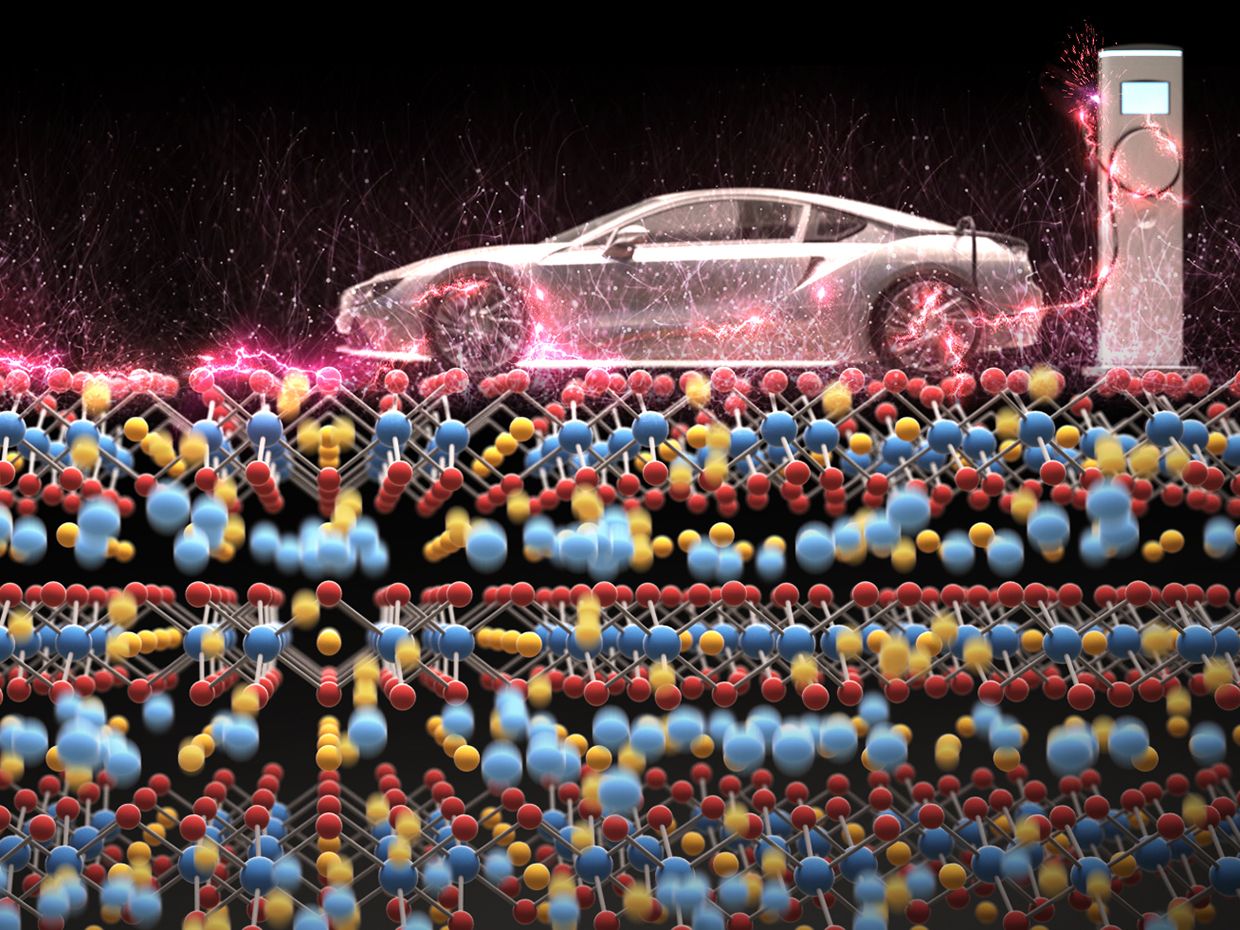New Analysis of Lithium-ion Batteries Shows How to Pack in More Energy
For the first time, scientists have studied the atomic structure of lithium-rich cathodes while they're charging
If electric vehicles are ever going to outcompete gas-powered ones, batteries must improve. Conventional lithium-ion batteries, the most energy-dense for their weight, can be charged to only about 50 percent of their theoretical capacity. When researchers have tried to pack more lithium into a battery’s electrodes, it hasn’t helped. The electrodes begin to quickly degrade after the first discharge/recharge cycle, and nobody has been able to figure out how to prevent it.
Now there’s a clue. Using a combination of theoretical computer modeling and sophisticated X-ray methods, researchers have for the first time found a relationship between the way atoms rearrange themselves in the electrode when it’s being charged and how electrons are stored in the battery’s atomic and chemical structures. This insight should give battery-makers a blueprint for building lithium-rich electrodes that could dramatically improve battery performance.
At its full potential, a lithium-rich battery could improve the range of today’s electric vehicles by a third or better. A Tesla Model S with the company’s P100D battery pack, for instance, could go from traveling 315 miles (about 500 kilometers) on a single charge to as far as 473 miles. Or the carmaker could keep the range at 315 miles but lower the price to compete with gas-powered vehicles without a rebate.
“The dream is to make an affordable mass-market electric vehicle that is the same upfront cost as a gasoline equivalent. Then the consumer starts saving gas money from day one, and everyone would switch to electric,” said William Gent, a Ph.D. student of chemistry at Stanford University and the first author on the study, which appears today in Nature Communications.
Gent worked with professor William Chueh, an investigator at Stanford University, along with researchers from the Lawrence Berkeley National Laboratory’s Advanced Light Source, on the project.
Conventional lithium-ion batteries are pretty straightforward, technically speaking. They have two electrodes—a positively charged cathode and a negatively charged anode—with a liquid electrolyte between them. The cathodes are made up of layers of lithium and transition metals, namely nickel, manganese, or cobalt.
When the battery is charged, lithium ions move from the positive electrode, through the liquid electrolyte, and then insert themselves into the material that makes up the negative electrode. The transition metal ions stay put. The same happens for electrons, except they travel across the circuit on their way to the negative electrode. Ions and electrons travel in the opposite direction when the battery is discharged.
Lithium-rich batteries replace some of the transition metals in the electrodes with lithium. Although the additional lithium has the potential to increase the cathode’s capacity by 30 to 50 percent, it creates some mysterious voltage behavior. For instance, the average charging voltage is higher than the average discharging voltage, even at low currents. In a perfect battery, said Gent, the voltages would be the same.
Also, the voltage gradually falls after going through cycles of charging and discharging. Electronic devices can’t manage such erratic voltage behavior, said Gent, because the circuits aren’t able to recalibrate on the fly in order to deal with the changes. That’s why lithium-rich electrodes have been so impractical.
In searching for solutions, previous researchers have typically looked at either how the ions rearrange themselves during charge/discharge cycles or how the electrons are stored in the battery’s atomic and chemical structures. Studying both simultaneously has been extremely difficult because it requires advanced analytical techniques to get the best picture, and not many research teams have access to the necessary equipment.
Gent and his colleagues were able to do that. They worked at two facilities that each had very bright, highly sensitive, and finely tuned X-ray sources to develop hypotheses for how the atomic rearrangements might affect the way electrons are stored within the material. They used X-ray diffraction at SLAC’s Stanford Synchrotron Radiation Lightsource to probe changes in the cathode’s atomic and chemical structure as it was being charged and discharged. At Lawrence Berkeley National Laboratory’s Advanced Light Source they used resonant inelastic X-ray scattering to measure the magnetic and electronic properties of the lithium-rich material.
Next, the scientists used computer models to test their hypotheses. They confirmed that when the lithium-rich cathode was charged, the transition metal ions, which normally stay in place in conventional batteries, moved around. They found that this rearrangement drastically impacts the voltage at which the electrons are stored in the cathode. This wouldn’t be so bad if the ions returned to their original location during discharge. But few did. And each time the battery was charged and discharged, the ions moved a little more, which created disorder in the atomic structure and caused the strange voltage behavior.
“We're hoping we can use this understanding to gain better control of these materials and make them more practical,” said Gent.
He and his colleagues have already begun to test different ways to address the problem. One idea is to prevent the transition metal ions from migrating. Another is to design the structure in a way that makes it easier for the migrating ion to return to its original position.
Tracy Staedter is a science writer, editor, writing coach, and consultant. Over the 20-plus years of her career, she has covered a range of science and technology stories from astrophysics to zero waste. She worked on staff for such publications as Astronomy, Scientific American Explorations, MIT Technology Review, DNews, and Seeker. She also wrote the illustrated book, Rocks and Minerals (part of the Reader’s Digest Pathfinders series) and founded the Fresh Pond Writers workshop for fiction and creative nonfiction writers. In addition to contributing to IEEE Spectrum, she writes for Discover, Smithsonian Air & Space, Mercury Magazine, Inside Science, and more.
